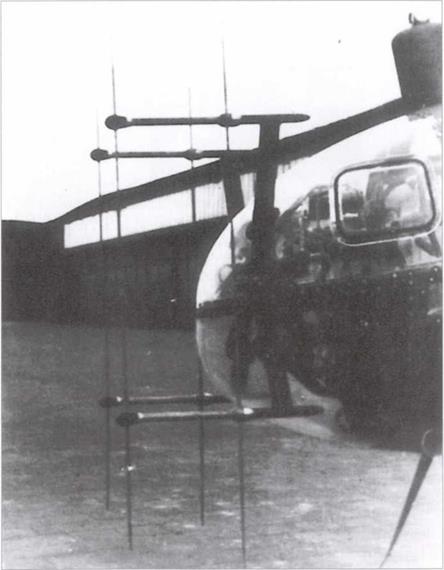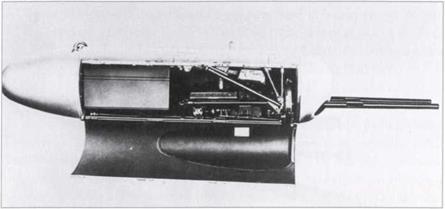Resumption of Long-Range Fighter Activities
At the end of 1944 OKL returned to the idea of the long-range night intruder. This was a tactic which had been tried out some years previously but discontinued on the instructions of higher authority. The idea was for multiengined night fighters to lurk near enemy airfields and shoot down enemy bombers in the act of landing following their return from missions. The first and last such operation of this kind, in 1945, was Operation Gisela. It had been postponed so often between November 1944 and February 1945 that enemy intelligence got wind of it, and the Allied propaganda radio station Soldatensender Calais would regularly play the hit song ‘Tonight I Dance Only with Gisela’ to unsettle the German crews listed to take part.
The operational plan was for German night fighters to infiltrate a bomber stream returning from Germany and attack over the RAF home airfields, following up with strafing attacks on parked aircraft or other rewarding ground targets. Category I crews from I. to III./NJG 2, IV./NJG З, I. to III./NJG 4 and III./NJG 5 were chosen. On the night of the operation the remaining night fighter units intercepted a heavy Allied formation, shooting down nine bombers. Of these, Hauptmann Greiner claimed three (his 49th to 51st victories) and Major Schnaufer two (his 117th and 118th victories). After 200 RAF bombers had attacked Munster, they turned for home pursued by Ju 88 G-6s, and headed for Flamborough Head to be vectored home. The German night fighters were observing radio silence and had orders not to attack the bombers over the sea thus retaining the element of surprise. Shortly before reaching the coast the Ju 88 pilots released chaff to foil the RAF early-warning system. Near the airfields German crews noticed impact fires as aircraft damaged by flak over the Reich and unable to land crashed into the ground.
Night fighters now bombed and gunned British airfields. All navigation lights at the bases were extinguished. The night-fighter ‘raider’warning was broadcast. A B-17 arriving and showing navigation lights was shot down from underneath by the upward-firing guns. IV./NJG 3 came across Lancaster bombers coming in to land and made several attacks from below. The burning bombers thus crashed near their home airfields. Incoming British aircraft now extinguished all lights. Once the Ju 88 G-6s had expended all ammunition the aircraft headed for the German North Sea coast, a flight of 600 kilometres, and after five next morning most landed safely at the nearest airfield with fuel tanks almost dry.
|
Amongst the few experimental versions of the Ar 234 B-2/NJ was this auxiliary night fighter used for tactical trials for the Ar 234jet night-fighter. |
At debriefing it was decided that the raid had paid off. Feldwebel Morenz (III./NJG 2) alone had claimed four bombers; Hauptmann Raht and Hauptmann Hissbach both had two. The other crews shared 12 between them. The RAF admitted the loss of 22 bomber aircraft. The Luftwaffe had sustained heavy losses, however. The Kommandeur of IV./NJG 3 baled out with his crew over northern Germany and was seriously injured, paralysis from the waist down
|
The Ar 234 auxiliary night fighter had fixed forward-facing guns in a WB 151 weapons holder slung below the fuselage in place of a bomb. |
being the consequence. His crew landed safely. The Staffelkapitan of 12./NJG 3 and his crew were not heard from again. Unteroffizier Lohse failed to return. Several crew were killed when a Ju 88 G-6 crashed at Marx with engine fire. Hauptmann Dreher’s D5#AX of 13./NJG 3, a Ju 88 G-6, was shot down over Elvington just after attacking a Halifax bomber landing at Pocklington. In an attack on a vehicle on the ground, a Ju 88 G-6 struck a tree and finally crashed into a farmhouse. While attempting to shoot down from below a В-24 Liberator ofTransport Command flying at 100 metres altitude at Metfield, the machine of Oberfeldwebel Leo Zimmermann (II./NJG 4) touched the ground and crashed, killing all aboard. Feldwebel Conze of III./NJG 5 attacked a car being driven by a member of the Home Guard at Welton. His Ju 88 G-6 hit telephone wires and crashed on top of the car. RAF night fighters stationed at Coltishall took off and shot down three Ju 88 G-6s, amongst them a Ju 88 G-6 of II./NJG 3 in the Welton area. 3C+KN of V./NJG 5 and one other aircraft failed to return that night. In this operation the Luftwaffe lost three other aircraft over England and 12 crews in crash-landings in Germany.
The operation did not have the success claimed for it. The number of aircraft committed to Gisela was too few for a major success. The action did show that direct attacks on enemy airfields would probably tie down RAF forces on the ground and in the air, and interfere with the timetable of Bomber Command flights, but even in the autumn of 1944 the Luftwaffe was simply not in a position to make such attacks. The fuel reassigned for Gisela meant that some night-fighter operations over the Reich had to be cancelled. The German night – fighter squadrons paid the price for the Luftwaffe failure at the beginning of the war to build and develop aircraft and radar to protect German-occupied territory in western Europe and over the Reich.












